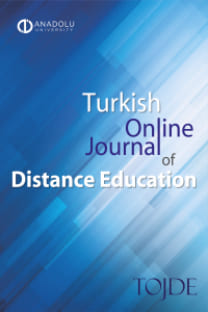DISRUPTIVE CHANGE AND LEARNING INNOVATIONS: CHALLENGES AND OPPORTUNITIES FOR UNIVERSITAS TERBUKA
DISRUPTIVE CHANGE AND LEARNING INNOVATIONS: CHALLENGES AND OPPORTUNITIES FOR UNIVERSITAS TERBUKA
___
- Belawati, T. & Nizam. (2020). Potret Pendidikan Tinggi di Masa Covid-19. Jakarta, Direktorat Jenderal Pendidikan Tinggi, Kementerian Pendidikan dan Kebudayaan. Black, A. (2010). Gen Y: Who they are and how they learn. Educational Horizons, 88(2), 92-101. Bozkurt, A., Jung, I., Xiao, J., Vladimirschi, V., Schuwer, R., Egorov, G., & Rodes, V. (2020). A global outlook to the interruption of education due to COVID-19 Pandemic: Navigating in a time of uncertainty and crisis. Asian Journal of Distance Education, 15(1), 1-126. https://doi.org/10.5281/ zenodo.3878572 Butcher, N., Kanwar, A., & Uvalic-Trumbic, S. (2011). A basic guide to open educational resources (OER). Commonwealth of Learning. UNESCO. Christensen, Horn, & Johnson. (2008). Disrupting Class. New York: Disrupting Class. Coman, C., Țîru, L. G., Meseșan-Schmitz, L., Stanciu, C., & Bularca, M. C. (2020). Online teaching and learning in higher education during the coronavirus pandemic: Students’ perspective. Sustainability, 12(24), 10367. Hall, P. (1996). Distance education and electronic networking. Information Technology for Development, 7(2), 75-89. Indonesian Cyber Education Institution. (2022). Retrieved from https://icei.ac.id/courses Laal, M., & Salamati, P. (2012). Lifelong learning; why do we need it? Procedia-Social and Behavioral Sciences, 31, 399-403. Manyika, J., Chui, M., Bughin, J., Dobbs, R., Bisson, P., & Marrs, A. (2013). Disruptive technologies: Advances that will transform life, business, and the global economy (Vol. 180, pp. 17-21). San Francisco, CA: McKinsey Global Institute. Market Research. (2020). Asia Pasific Learning management System Market Forecast 2019-2027). Rockville: Inkwood Research. Masalimova, A. R., Khvatova, M. A., Chikileva, L. S., Zvyagintseva, E. P., Stepanova, V. V., & Melnik, M. V. (2022). Distance learning in higher education during COVID-19. In Frontiers in Education (p. 120). Frontiers. Meyer, K. A. (2010). The role of disruptive technology in the future of higher education. Educause Quarterly, 33(1). Ministry of Education and Culture. (2019). Strategic Plans 2020-2024. Jakarta. Ministry of Education and Culture Publisher. Moeldoko. (2020). Transformation to digital society through online learning. Presented on UT’s 7th Knowledge Sharing Forum (KSF). Retrieved at https://sl.ut.ac.id/materiksf7 Padmo, D., Ardiasih, L.S., & Idrus, O. (2020). Online Learning During the Covid-19 Pandemic and Its Effect on Future Education in Indonesia. In Ljupka Naumovska (Ed.), The Impact of COVID19 On the International Education System (pp.71-86). Proud Pen. https://doi.org/10.51432/978-1- 8381524-0-6_5 Statista. (2022). Enrollment Rate in Indonesia from 2015 to 2021, by education level. https://www.statista. com/statistics/1127610/indonesia-enrollment-rate-by-education-level/ UNESCO. (2019). Recommendation on Open Educational Resources (OER). Retrieved on September 9, 2022, from https://unesdoc.unesco.org/ark:/48223/pf0000373755/ PDF/373755eng.pdf.multi. page=3 Universitas Terbuka. (1984). Decreet of the President of the Republic of Indonesia Universitas Terbuka (2020). Business Stretegic Plan Universitas Terbuka Year 2021-2025. Jakarta: Universitas Terbuka Universitas Terbuka. (2022). Universitas Terbuka Rector’s Annual Report. Yarrow, N. (2020). Covid-19 in East Asia: How the Region’s Higher Education Systems are Addressing the Crisis to Adapt to the Future. Retrieved from https://blogs.worldbank.org/education/covid-19- east-asia-how-regions-higher-education-systems-are-addressing-crisis-adapt
- ISSN: 1302-6488
- Başlangıç: 2000
- Yayıncı: Anadolu Üniversitesi
DISRUPTIVE CHANGE AND LEARNING INNOVATIONS: CHALLENGES AND OPPORTUNITIES FOR UNIVERSITAS TERBUKA
Ojat DAROJAT, Olivia IDRUS, Lidwina Sri ARDIASIH
BLENDED LEARNING IN HIGHER EDUCATION: A BIBLIOMETRIC ANALYSIS
Mustafa Tevfik HEBEBCI, Nilay OZER
Wawan KRISMANTO, Punaji SETYOSARI, Dedi KUSWANDI, Henry PRAHERDHIONO
Hakan ALTINPULLUK, Yusuf YILDIRIM
Valentine Joseph OWAN, Onyinye CHUKTU, Ann E. DIJEH, Abderrazak ZAAFOUR, Julius U. UKAH, Margaret U. CHUKWURAH, Denis A. UBE, Michael E. ASUQUO, Esuong U. UWASE, Udida J. UDIDA, Cyprian O. OJONG
SYNCHRONOUS VIRTUAL LEARNING STUDENTS’ EXPERIENCE AND THE PROSPECT IN VIETNAM
Mai Thi Truc LE, Khue Van TRAN
Nilgun OZDAMAR, Fusun CURAOGLU, Emre TUFEKCIOGLU, Duysal TUTUNCU DEMIRBAS
